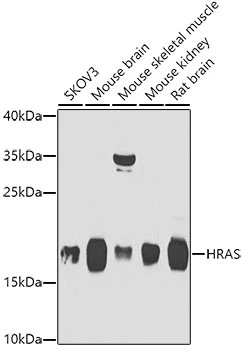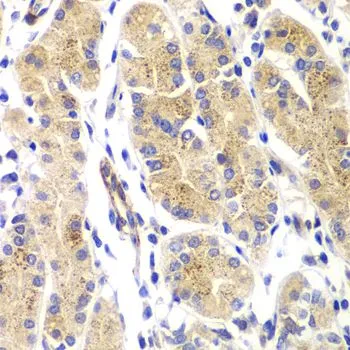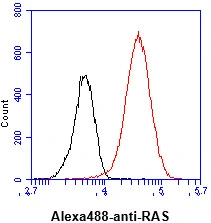
WB analysis of various sample lysates using GTX55665 H-Ras antibody. The signal was developed with ECL plus-Enhanced. Dilution : 1:1000 Loading : 25microg per lane
H-Ras antibody
GTX55665
ApplicationsWestern Blot, ImmunoHistoChemistry, ImmunoHistoChemistry Paraffin
Product group Antibodies
TargetHRAS
Overview
- SupplierGeneTex
- Product NameH-Ras antibody
- Delivery Days Customer9
- Application Supplier NoteWB: 1:500 - 1:2000. IHC-P: 1:50 - 1:200. *Optimal dilutions/concentrations should be determined by the researcher.Not tested in other applications.
- ApplicationsWestern Blot, ImmunoHistoChemistry, ImmunoHistoChemistry Paraffin
- CertificationResearch Use Only
- ClonalityPolyclonal
- ConjugateUnconjugated
- Gene ID3265
- Target nameHRAS
- Target descriptionHRas proto-oncogene, GTPase
- Target synonymsC-BAS/HAS, C-H-RAS, C-HA-RAS1, CTLO, H-RASIDX, HAMSV, HRAS1, RASH1, p21ras, GTPase HRas, GTP- and GDP-binding peptide B, Ha-Ras1 proto-oncoprotein, Harvey rat sarcoma viral oncogene homolog, Harvey rat sarcoma viral oncoprotein, Ras family small GTP binding protein H-Ras, c-has/bas p21 protein, p19 H-RasIDX protein, transformation gene: oncogene HAMSV, transforming protein p21, v-Ha-ras Harvey rat sarcoma viral oncogene homolog
- HostRabbit
- IsotypeIgG
- Protein IDP01112
- Protein NameGTPase HRas
- Scientific DescriptionThis gene belongs to the Ras oncogene family, whose members are related to the transforming genes of mammalian sarcoma retroviruses. The products encoded by these genes function in signal transduction pathways. These proteins can bind GTP and GDP, and they have intrinsic GTPase activity. This protein undergoes a continuous cycle of de- and re-palmitoylation, which regulates its rapid exchange between the plasma membrane and the Golgi apparatus. Mutations in this gene cause Costello syndrome, a disease characterized by increased growth at the prenatal stage, growth deficiency at the postnatal stage, predisposition to tumor formation, cognitive disability, skin and musculoskeletal abnormalities, distinctive facial appearance and cardiovascular abnormalities. Defects in this gene are implicated in a variety of cancers, including bladder cancer, follicular thyroid cancer, and oral squamous cell carcinoma. Multiple transcript variants, which encode different isoforms, have been identified for this gene. [provided by RefSeq, Jul 2008]
- Storage Instruction-20°C or -80°C,2°C to 8°C
- UNSPSC12352203





![WB analysis of various samples using GTX80140 H-Ras antibody [H-RAS-03]. Lane 1 : HeLa Lane 2 : K567 Lane 3 : Raji](https://www.genetex.com/upload/website/prouct_img/normal/GTX80140/GTX80140_20191028_WB_1_w_23061322_427.webp)
